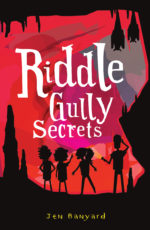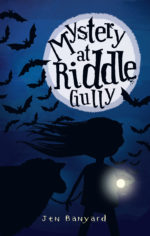Jen Banyard on writing Riddle Gully Runaway

West Australian teachers may already know Jen from the serialisation of Mystery at Riddle Gully in the Ed! Section of The West Australian. Her latest book Riddle Gully Runaway can be read as a follow-up to Mystery at Riddle Gully or as a stand-alone book. Jen loves writing humour and her books are fantastic adventure stories but they also incorporate the important stuff – compassion, self-acceptance and open-mindedness.
Does Riddle Gully Runaway aim to teach young readers any life lessons? If so, what are they? And, how are they taught throughout the book?
I aim to write a great story first because, bottom line, if the story’s dull there’s no point in me trying to spread my wisdom because no one will be reading it. That said, I do bandy a few morally interesting ideas about. The overarching theme of my novels to this point would be open-mindedness, thinking twice before condemning (the spider in Spider Lies, the ‘vampire’ in Mystery at Riddle Gully, Benson in the current novel). I admit, I’d love to think my books, Runaway included, might be part of a hotchpotch of influences that steer young readers towards having open hearts and minds.
Of course, anything with a whiff of moralising I try my darnedest to disguise with humour or action. I remember how I used to respond to being told what to think.
An important theme of the novel is resilience. How did you portray this through your writing and your characters? What do you aim to teach readers about resilience?
I think resilience is a key to enjoying life. Happiness isn’t about enjoying the good things life brings – that’s easy. It’s about coping well – being resilient – with the difficult stuff. When things go badly for the character Benson he feels sorry for himself and the way he responds makes his situation worse. The characters Pollo and Will show him a pathway out of the mire – a way to forgive himself and move on. There’s interplay on this theme, too, between Pollo and Will. Will is cautious, self-deprecating and pessimistic, whereas Pollo, the optimist, can’t be squashed and probably isn’t cautious enough. She leads Will to leave his comfort zone, take risks and test his limits, helping him to find strengths he didn’t know he had. (Will, on the other hand, teaches Pollo things like empathy.)
Does the book aim to teach young readers about forgiveness? How?
I know we can’t all be angels but we can try, eh? I hope that some of the stuff in there about forgiveness rubs off, especially the glint that forgiving can make the person doing the forgiving feel a heck of a lot better. People aren’t perfect and if we all went around harbouring niggles and crossing off friends it would be a pretty dismal world.
Perhaps a key difference in Runaway is that it also touches on forgiving oneself. Will, who has plenty of forgiving to do in his own life, leads Benson to the idea of ‘making friends’ with his problems. Will and Pollo help Benson accept what he doesn’t like about himself and commit to a positive way forward. (It worries me that the distinction between being ‘the best you can be’ and being ‘the best’ or ‘brilliant’ or even ‘very good’ is often blurred. I was chatting with a psychologist about this and he told me about ACT– Acceptance and Commitment Therapy – which I draw from in the book.)
In writing Riddle Gully Runaway, did you use any writing strategies that could be useful to young writers? Do you have any advice for young writers?
Don’t be imprisoned by your computer or notepad! Get physical with your ideas! With Runaway, I had a bunch of ideas for things I wanted to happen in the book – but no idea of how to structure them. So I made squares of paper, wrote one idea on each square and manoeuvred them around on the table like jigsaw pieces until they cohered into a narrative I thought would work.
Here’s a picture of what that looked like (I’m on Rottnest Island):

Other writers have desks, floors, windows and walls plastered with bits and pieces relevant to their current project.
My main overall advice to budding writers is to be persistent. As with any pastime or job, there’ll be times when you don’t feel inspired. But suck it up, man! Press on! Come back and change the dross you wrote the day before. At least, that way, you’ve something to work with.
If you were a teacher, how would you use your book in the classroom? What kinds of activities are available to them in the teaching notes? Do you have a favourite?
It’s an adventure for both genders, it’s funny and it’s life affirming, so first and foremost, I’d use it to engage students with the pleasures of reading. There are also sparks in there to provoke mindfulness and some interesting discussion – things like redeeming oneself, risk-taking vs building resilience, optimism vs pessimism, the different elements of forgiveness, or self-esteem and how it can be shaped for good or bad. Activities for these are developed in the teaching notes.
One of my favourite activities is taking the pivotal character Benson – who is alternately a thief, a musician, a friend, a homeless person, a vulnerable new worker, a loving grandson and a rebellious nephew – and creating a Cubist-style portrait of him that includes some of these various aspects. It highlights the fact that we humans are complex creatures who can’t be pigeonholed.





